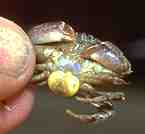|
|
Carnivores
There are a number of carnivores which live on our shores. Some are swift, efficient hunters, roaming over the rock surfaces hunting down their prey. Fish such as Snapper, Chrysophrys auratus, Yellow Fin Bream, Acathopagrus australis, hunt when the tide is high. The Cyan-coloured Octopus, Octopus cyaneus and Rocky Shore Blue-Ringed Octopus, Hapalochaena sp. which are also found on rocky shores are efficient hunters. If you are fortunate enough to see an octopus hunting down a crab, you will see just how clever and efficient it is.
Birds such as the Sooty Oyster Catcher, Haematopus fuliginosus, hunt when the tide is low.
There
are other hunters too. Not so fast, but no less efficient. ![]() I
have seen the Reef Crab, Ozius truncatus,
eating nematocyst-charged Blue-bottles, Psysalia ultriculus. That
would give a "sting" to the meal.
I
have seen the Reef Crab, Ozius truncatus,
eating nematocyst-charged Blue-bottles, Psysalia ultriculus. That
would give a "sting" to the meal.
![]() There
are a number of carnivorous molluscs of various sizes.
There
are a number of carnivorous molluscs of various sizes. ![]() The
largest ones of the low shore, low fringe level and marine zone are the
Cart-rut Shell, Dicathais orbita, and
Spenglers Rock Whelk, Cabestana spengleri
which eats Cunjevoi, Pyura stolonifera.
The
largest ones of the low shore, low fringe level and marine zone are the
Cart-rut Shell, Dicathais orbita, and
Spenglers Rock Whelk, Cabestana spengleri
which eats Cunjevoi, Pyura stolonifera.
![]() Another
smaller, wide ranging carnivorous mollusc is the abundant Mulberry
Whelk, Morula marginalba, found on eastern shores.
Another
smaller, wide ranging carnivorous mollusc is the abundant Mulberry
Whelk, Morula marginalba, found on eastern shores.
![]() The
Mulberry Whelk eats the Common Variegated
Limpet, Cellana tramoserica, and a wide range of barnacles including
the Six-plated Barnacle, Cthamalus
antennatus, Rose-coloured Barnacle,
Tesseropora rosea, Surf Barnacle, Catomerus
polymerus and others.
The
Mulberry Whelk eats the Common Variegated
Limpet, Cellana tramoserica, and a wide range of barnacles including
the Six-plated Barnacle, Cthamalus
antennatus, Rose-coloured Barnacle,
Tesseropora rosea, Surf Barnacle, Catomerus
polymerus and others.
![]() The
Mulberry Whelk has the ability to drill a hole through the shell
of their prey, stick their saw-like radula tongue in through the hole,
to chop up their prey. They then suck the juices out. It is believed that
they place a drop of stomach acid onto the lime of the prey's shell, which
assists the carnivore to drill its deadly hole. This process is believed
to take only two high tides.
The
Mulberry Whelk has the ability to drill a hole through the shell
of their prey, stick their saw-like radula tongue in through the hole,
to chop up their prey. They then suck the juices out. It is believed that
they place a drop of stomach acid onto the lime of the prey's shell, which
assists the carnivore to drill its deadly hole. This process is believed
to take only two high tides.
The Wine-mouthed Lepsiella, Lepsiella vinosa, and Flinder's Lepsiella, Lepsiella flindersi are small carnivorous molluscs from southern shores. They feed on barnacles and mussels.
Many of the worms are effective predators, having mouthparts that lunge outwards to capture unsuspecting prey.
![]() Other
slow movers, but no-less efficient hunters are the predatory Sea Stars,
including the Eleven-armed Sea Star,
Cosinasterias calamaria.
Other
slow movers, but no-less efficient hunters are the predatory Sea Stars,
including the Eleven-armed Sea Star,
Cosinasterias calamaria.
![]() Some
other carnivores do not actively hunt their prey, but wait for a straying
animal to come to them. Examples are the anemones,
Some
other carnivores do not actively hunt their prey, but wait for a straying
animal to come to them. Examples are the anemones, ![]() including
the Waratah Anemone, Actinea tenebrosa
and Sand Anemone, Oulactus muscosa.
Anemones have stinging nematocysts and sticky tentacles, which are hard
to escape.
including
the Waratah Anemone, Actinea tenebrosa
and Sand Anemone, Oulactus muscosa.
Anemones have stinging nematocysts and sticky tentacles, which are hard
to escape.
Parasites:
 A
specialised group of carnivores are the parasites. They do not deliberately
kill off their prey, but attach themselves to their host in a way so that
they can feed off their tissues, but not actually kill their host. One
example is the parasitic barnacle
and the Smooth-handed Crab, Pilumnopeus
serratifrons.
A
specialised group of carnivores are the parasites. They do not deliberately
kill off their prey, but attach themselves to their host in a way so that
they can feed off their tissues, but not actually kill their host. One
example is the parasitic barnacle
and the Smooth-handed Crab, Pilumnopeus
serratifrons.
References:
Bennett, I. (1987) W. J. Dakin's classic study: Australian Seashores. Angus & Robertson, Sydney.
Davey, K. (1998) A Photographic Guide to Seashore Life of Australia. New Holland, Sydney.
Edgar, G. J. (1997) Australian Marine Life: the plants and animals of temperate waters. Reed Books, Kew.
Quinn, G. P., Wescott, G. C. & Synnot, R. N. (1992) Life on the Rocky Shores of South-eastern Australia: an illustrated field guide. Victorian National Parks Association, Melbourne.
Marine Research Group of Victoria (1984) Coastal Invertebrates of Victoria: an atlas of selected species. Museum of Victoria, Melbourne.
Shepherd, S. A. & Thomas, I. M. (1982) Marine Invertebrates of Victoria, Pt. 1. South Australian Government Printer, Adelaide.
Underwood, A. J. & Chapman, M. G. (1993) Seashores: a beachcomber's guide. New South Wales University Press, Sydney.
Nutrient
Absorbers
Grazers & Browsers
Suspension Feeders
Deposit Feeders
Carnivores
Omnivores
Trophic Levels
Energy Pyramid
Home
Page
Taxonomy
Biogeography
Rocky Shores
Tidal Levels
Intertidal Zonation
Environmental Factors
Biological
Factors
Feeding Relationships
Activities
Glossary
References
 Life
on Australian Seashores
Life
on Australian Seashores
by Keith Davey (C) 2000
Learning Consultant
- Media
The University of Newcastle
email at australian_seashores@hotmail.com
Scientific Consultant: Phil
Colman
site created 01.01.98 : updated 01.04.2000
